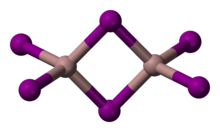This is an old revision of this page, as edited by Nirmos (talk | contribs) at 15:21, 26 January 2010 (Corrected subscript.). The present address (URL) is a permanent link to this revision, which may differ significantly from the current revision.
Revision as of 15:21, 26 January 2010 by Nirmos (talk | contribs) (Corrected subscript.)(diff) ← Previous revision | Latest revision (diff) | Newer revision → (diff)
| |
| Names | |
|---|---|
| Other names gallium triiodide | |
| Identifiers | |
| CAS Number | |
| ECHA InfoCard | 100.033.269 |
| PubChem CID | |
| CompTox Dashboard (EPA) | |
| Properties | |
| Chemical formula | Ga2I6 |
| Molar mass | 450.436 g/mol |
| Appearance | light yellow powder |
| Density | 4.15 g/cm |
| Melting point | 212 °C |
| Boiling point | 345 °C |
| Solubility in water | decomposes |
| Hazards | |
| NFPA 704 (fire diamond) |
 |
| Except where otherwise noted, data are given for materials in their standard state (at 25 °C , 100 kPa). Infobox references | |
Gallium(III) iodide is the chemical compound with the formula Ga2I6. It is the most common iodide of gallium. In the chemical vapor transport method of growing crystals of gallium arsenide uses iodine as the transport agent. It reversibly forms GaI3.
Gallium triiodide can be reduced with gallium metal to give a green-colored solid called "gallium(I) iodide." The nature of this species is unclear, but it is useful for the preparation of compounds of gallium(I) and galium(II) and is reported as useful in organic syntheses.
References
- C. Brünig, S. Locmelis, E. Milke, M. Binnewies, "Chemischer Transport fester Lösungen. 27. Mischphasenbildung und chemischer Transport im System ZnSe/GaAs" Zeitschrift für anorganische und allgemeine Chemie 2006, 632, 6 , 1067 - 1072. doi:10.1002/zaac.200600008
- Baker, Robert J.; Jones, Cameron. ""GaI": A versatile reagent for the synthetic chemist" Dalton Transactions (2005), (8), pp. 1341-1348. doi:10.1039/b501310k
- GaI: A new reagent for chemo- and diastereoselective C–C bond forming reactions, Green SP, Jones C., Stasch A., Rose R.P, New J. Chem., 2007, 31, 127 - 134, doi:10.1039/b613669a
See also
| Gallium compounds | |||
|---|---|---|---|
| Gallium(−V) | |||
| Gallium(I) | |||
| Gallium(II) | |||
| Gallium(I,III) | |||
| Gallium(III) |
| ||
This inorganic compound–related article is a stub. You can help Misplaced Pages by expanding it. |